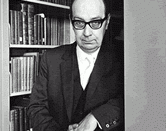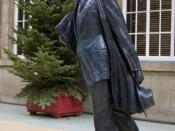In Cut Grass, Philip Larkin uses onomatopoeia, color and flower symbolism, and punctuation to show that death is inevitable, and is unaware of specific circumstances. By contrasting the cut grass with the typically vibrant, lively month of June, Larkin shows the harsh nature of death, and its disregard towards its surroundings, while simultaneously providing a sense of hope once death does arrive.
In the first stanza, Larkin uses onomatopoeia to create a vivid image of mown grass. The sharp sounds of "cut grass" imply fierceness, while the next phrase "lies frail," is reminiscent of helplessness and weakness. He continues to parallel sounds by using phrases such as "brief is the breath," and "exhale," whose sounds resemble their respective actions. Through his use of onomatopoeia, Larkin connects the reader to the grass, and thus evokes sympathy. While the reader is sensitive towards the death, it nonetheless continues, regardless of the liveliness of "young-leafed June."
Larkin also contrasts the "brief breath" with "long death" to show that life is relatively brief when compared to the eternity of death. He makes the majority of the poem, in describing death, one sentence, from "long, long..." until the end, in order to illustrate the prolonged and slow dying. He describes the death "at summer's pace;" a lazy and dawdling movement that disregards its blooming surroundings. He shows that death is unavoidable, and is continually occurring, even at supposed joyful moments. However, Larkin also ends the poem with movement, to show that death, although inevitable, is not necessarily final, and that there is potential for an afterlife.
The repeated reference to white also serves to show the two sides of death; while it is pure and innocent, it is also melancholy. By personifying death, Larkin shows that though one can evaluate death from different perspectives,


